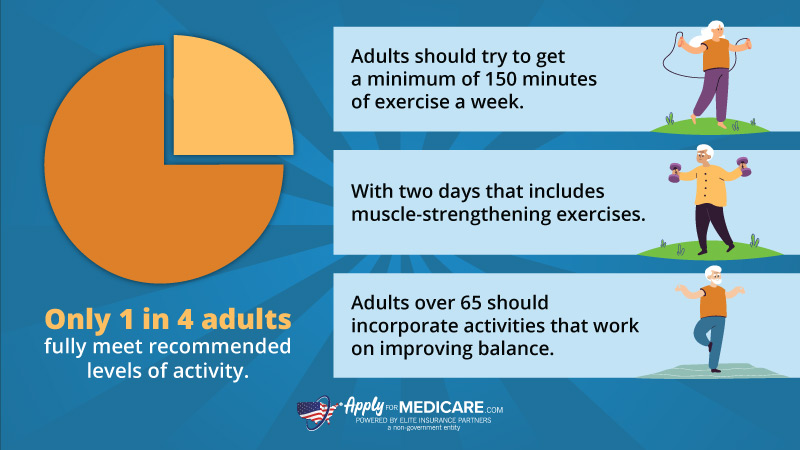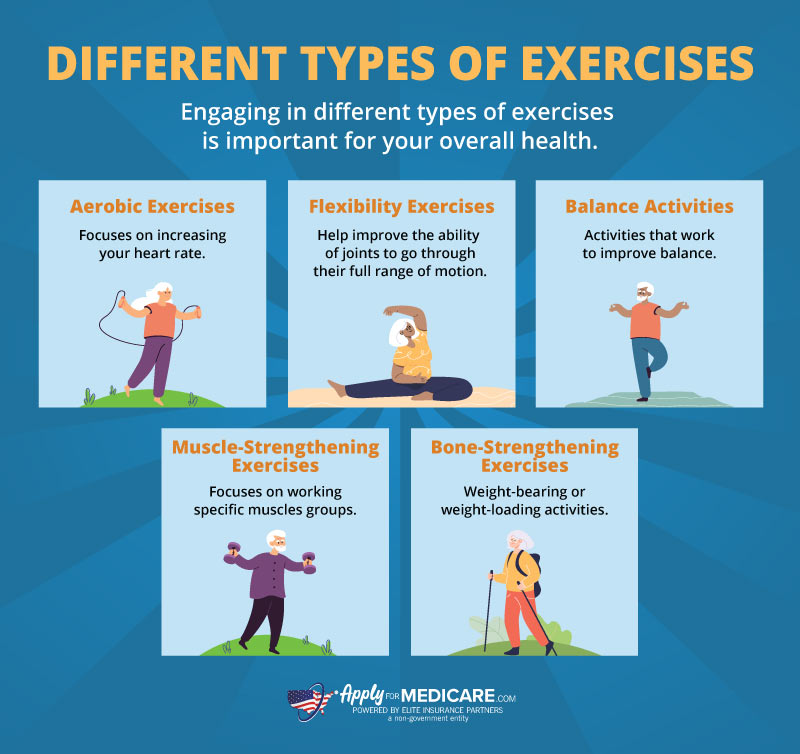Summary: No matter your age, staying active and fit is essential for improving your health and reducing your risk of certain chronic conditions and illnesses. In this article, we’ll review general activity recommendations from various health organizations and tips for exercising safely as you age. Estimated Read Time: 8 min
Table of Contents:
- General Guidelines for Health
- Types of Exercise
- How To Adapt Your Fitness Routine as You Age
- How To Exercise Safely
We often hear how staying active can improve our health and reduce our risk of certain diseases and conditions. Yet only 1 in 4 adults fully meet recommended levels of activity. Luckily, it is never too late to develop a fitness routine and stay active. No matter your age, engaging in physical activity can benefit your mental and physical health.
Physical activity has several positive effects on our health. According to the CDC, exercising long-term can reduce your risk of depression, dementia, fall-related injuries, heart disease, certain cancers, and more. Exercising even has immediate effects such as reducing stress and improving sleep quality. Below, we’ll explain how you can stay active and fit no matter your age.
General Guidelines for Health
Though fitness and physical activity guidelines will vary for individuals based on their specific health conditions and needs, the Centers for Disease Control and Prevention (CDC) and the World Health Organization (WHO) have general guidelines for healthy amounts of physical activity.
Children and adolescents should have at least 60 minutes of moderate-to-vigorous physical activity daily. Muscle and bone strengthening exercises should be included at least three days a week.
Adults should focus on getting at least 150 minutes a week of moderate physical activity. Each week, two days should include activities that focus on strengthening muscles.
Older adults, such as individuals over 65, should follow the same guidelines as adults with the addition of exercises focusing on improving balance.

Even if you have a disability or chronic condition, the CDC still recommends getting as much physical activity as is safe and possible for your condition. People of all ages should engage in a variety of types of exercises including aerobic exercises and muscle strengthening exercises.
Types of Exercise
The World Health Organization defines physical activity as “any bodily movement produced by skeletal muscles that requires energy expenditure”. Exercise is a form of physical activity that is planned, repetitive, and performed with the goal of improving health and fitness. Exercises can be broken down into categories such as aerobic exercises and balance activities.
- Aerobic Activity: also referred to as cardio activity, aerobic activity focuses on increasing your heart rate. Examples: Brisk walking, jogging, biking, swimming
- Muscle-Strengthening Activity: focuses on working specific muscle groups in the body. Examples: Resistance training, weightlifting
- Bone-Strengthening Activity: also referred to as weight-bearing or weight-loading activity. Examples: Jumping jacks, running, weightlifting exercises
- Balance Activities: activities that work on improving overall balance. Examples: Walking backwards, standing on one leg, using a wobble board
- Flexibility Exercises: activities that help improve the ability of joints to move through the full range of motion. Examples: Stretching, Yoga, dancing

Though people of all ages can benefit from engaging in all types of exercises, certain activities become more important during different stages of your life. Below, we’ll discuss general physical activity recommendations for different age groups.
Teens
According to the CDC, teenagers should be engaging in 60 minutes or more of moderate-to-vigorous physical activity every day, with at least three days a week containing vigorous activity. Though most of the 60 minutes of activity should be aerobic activity, teens should also spend three days a week doing activities that contribute to muscle and bone growth. As teenagers become busier with schoolwork and part time jobs, it’s important to continue to encourage them to maintain a healthy level of physical activity.
Adults in Their 20s
Your 20s is a great time to make exercise a habit and develop a strong foundation for fitness. Adults in their 20s should strive to do a minimum of 150 minutes of moderate physical activity a week and can see even more health benefits if they increase that activity to 300 minutes per week. People in their 20s generally have strong and resilient bodies and can safely engage in sports and rigorous activities like hiking.
Adults in Their 30s
Adults in their 30s may start losing muscle mass and bone strength due to age. During this time, you should make sure to incorporate muscle-strengthening exercises and weight-bearing exercises into your routine. Adults in their 30s should still try to maintain 150-300 minutes of moderate to vigorous exercise each week but consider mixing up your routine to challenge different muscle groups in your body.
Adults in Their 40s
Some people may notice that weight gain comes easier in their 40s. Slowing metabolism and loss of muscle can reduce our body’s ability to burn fat. It’s essential in your 40s to keep up with a fitness routine, aiming for those 150-300 minutes of exercise per week. During your 40s, it may be more comfortable to do less vigorous activities and more moderate activities; for example, you may start walking brisky instead of running.
Adults in Their 50s
During your 50s, you may start to experience aches or pains in your body due to age. It’s important to adapt and change your exercises to meet the needs of your body. You may consider switching to low-impact exercises such as swimming or biking. You can continue to meet activity recommendations, even if you need to reduce the intensity of your workouts. When reducing the intensity of your exercises, consider increasing the time spent exercising, such as swapping 30 minutes of jogging for one hour of walking.
Adults in Their 60s
Remaining physically active into your 60s can have a substantial impact on your health. Even if you weren’t physically active prior to your 60s, it’s never too late to start. Adults in their 60s should still focus on getting at least 150 minutes of exercise per week while adding balance activities into their routine. The combination of balance activities, aerobic exercises, and muscle-strengthening activities can help reduce your risk of falls while keeping you active and mobile.
Adults in Their 70s
The physical activity recommendations for individuals in their 70s doesn’t change much from your 60s. However, in your 70s, chronic conditions may impact how you exercise and how long you’re able to exercise for. Discuss exercise with your doctor to establish a plan that works for you. During your 70s, you will want to make sure you’re spending more time stretching and warming up before performing any physical activities.
Adults in Their 80s
As we enter our 80s, we may notice an increase in limitations when it comes to strength and mobility. However, even older adults with functional limitations can still benefit from regular physical activity. Low-impact exercises like walking or water aerobic exercises are a great way to stay active in your 80s.
Adults in Their 90s Plus
Adults aged 90 and older can continue to receive health benefits associated with regular physical activity. Harvard Health Publishing lists mental barriers as a common reason that people don’t move as much as they should. As you reach your 90s, it’s important to remember that you’re not too old to engage in physical activity. Speak with your doctor and other healthcare professionals about creating an exercise plan that is appropriate for your age and health.
How To Adapt Your Fitness Routine as You Age
Adapting your fitness routine as you age is important because your needs and limitations change over time. A few ways you can adapt your routine include:
- Incorporate new types of physical activity, such as balance exercises
- Replace short, high-intensity workouts with longer, moderate-intensity workouts
- Switch to low-impact exercises that are easy on your joints
- Increase/decrease amount of exercise according to changes in health issues and conditions
How To Exercise Safely
As we age it becomes increasingly more important to approach exercise in a safe manner. Exercising incorrectly or without the right equipment can result in injuries that can have a significant impact on your day-to-day life. Injury risks may make you hesitant to engage in physical activity. Luckily, there’s steps you can take to reduce those risks so you can maintain a healthy level of physical activity.
Below are some helpful tips from the U.S. Department of Health and Human Services on how to stay safe while exercising:
- Choose physical activities that are appropriate for your age and current fitness level.
- Start slowly and gradually increase your activity and intensity over time.
- Take time to stretch and warm up before beginning any rigorous activities.
- Use appropriate gear and equipment.
- If you have chronic conditions, consult your healthcare provider or a physical activity specialist to learn which activities will be appropriate for you.
- Stay hydrated.
Though there are many steps you can take to reduce your risk of injury, there is still a chance you could incur an injury while exercising. It’s important that you ensure you can get the care you need in the event of an injury. When establishing a fitness plan, take time to review your health plan to make sure you can get the care you need without breaking the bank.
If you are eligible, make sure you sign up for Medicare before you lose your employer group coverage. If you need outpatient care, like physical therapy due to an injury, it will be covered under your Medicare Part B. If you notice gaps in your coverage, such as not having drug coverage, you may need to apply for a Medicare Part D drug plan.
Getting injuries treated quickly and properly can help you get back on your fitness journey quicker. In some cases, you may need to start slow and work back up to your previous activity level. Though it may feel discouraging to be doing less activity, it’s important to follow your doctor’s recommendations to avoid re-injury. Remember: fitness is a lifelong journey; it will change and fluctuate throughout your life. The important thing is to keep moving and keep finding ways to incorporate physical activity into your life.

